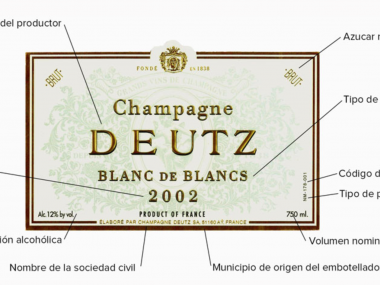Acidity in wine refers to the level of acidity present in the wine, which affects its taste and its ability to age. Acidity in wine is the result of organic acids naturally found in grapes, such as tartaric, malic and citric acid.
This acidity is important because it provides a feeling of freshness and liveliness on the palate. Wines with adequate levels of acidity are more balanced and taste better than wines with low levels of acidity. In addition, acidity also helps to preserve the wine and prolong its shelf life.
In terms of food pairing, wines with higher acidity pair well with high-fat foods, such as fatty meats or dishes with creamy sauces, as the acidity helps to cut the fat and cleanse the palate.
Where does the acidity in a wine come from?
The acidity of wine comes from the organic acids present in the grapes, which are transferred to the must during the winemaking process. Grapes contain several types of organic acids, the most common are:
- Tartaric acid: this is the most important acid in wine and is found in grapes in large quantities.
- Malic acid: also common in grapes, but is converted to lactic acid during malolactic fermentation, a process that can occur in some wines after alcoholic fermentation.
- Citric acid: is the least common of the three acids and is generally found at very low levels in grapes.
In addition to these organic acids, the level of acidity in wine can also be affected by other factors, such as the climate and location of the vineyards, the ripeness of the grapes, the time of harvest, the type of yeasts used in fermentation, the type of barrels in which the wine is aged and other factors in the winemaking process.
What are the acids that can appear after fermentation, storage and ageing of the wine?
After fermentation, storage and ageing of wine, different acids can appear due to microbial and chemical activity. Some of the acids that can appear in wine during these processes are:
Lactic acid
Lactic acid can appear in wine after malolactic fermentation, a process in which certain bacteria transform the malic acid present in the wine into lactic acid. Lactic acid softens the acidity of the wine and can provide a smoother, rounder texture on the palate.
Acetic acid
Acetic acid is produced during alcoholic fermentation and can appear in wine after fermentation. Acetic acid is commonly found in vinegar and in small amounts can impart a vinegary flavour to wine, although too much can be considered a defect.
Succinic acid
Succinic acid can appear in wine after fermentation, and can provide a sensation of freshness and acidity on the palate. Succinic acid can also bring notes of fruit and spice to the wine.
Pyruvic acid
Pyruvic acid can appear in wine during ageing and can contribute fruit and spice notes as well as a sensation of acidity and freshness on the palate.
It is important to note that the appearance of these acids depends on the type of wine and the winemaking process used. In general, a good balance of acids in wine is essential for its quality and longevity.
What is the sensation of each type of acid in wine?
Each type of acid present in wine produces different sensations on the palate:
Tartaric acid
It is the predominant acid in wine and produces a sensation of freshness and acidity on the palate. It contributes to the structure and body of the wine, as well as to the perception of fruit flavour.
Tartaric acid also helps to preserve the wine and prolong its shelf life.
Malic acid
This acid is found naturally in grapes and is converted to lactic acid during malolactic fermentation. Malic acid produces a softer acidity sensation on the palate than tartaric acid, giving a fresh feel and a smooth texture to the wine.
Citric acid
It is the least common acid in wine, but when present, it produces a very fresh and bright acidity sensation on the palate. Citric acid is the acid found in citrus fruits, such as oranges or lemons.
It is important to note that the perception of acidity in wine depends not only on the type of acid present, but also on the concentration and balance between the different acids. A good wine will have a proper balance between the different acids, which will result in a pleasant sensation of acidity and freshness on the palate.
What are the parameters to be measured to determine the quality of a wine by its acidity?
To determine the quality of a wine by its acidity, it is necessary to measure several parameters, such as:
The pH
The pH is a measure of the acidity or alkalinity of a solution. In wine, the ideal pH is between 3.0 and 3.5. If the pH is too high, the wine will be less acidic, while if the pH is too low, the wine will be too acidic.
Total acidity
Total acidity is a measure of all the acids present in the wine, including tartaric, malic, citric and other acids. The ideal total acidity varies according to the type of wine, but is generally between 5 and 8 g/L.
If the total acidity is too low, the wine will have a flabby sensation on the palate, while if it is too high, the wine will be too acidic.
Volatile acidity
Volatile acidity is a measure of the volatile organic acids in wine, such as acetic acid. Volatile acidity can impart a vinegary taste to wine and, if it is too high, it can be considered a defect.
Acidity and sugar balance
In addition to measuring acidity levels, it is also important to measure the balance between acidity and sugar in the wine. Sugar can provide a sense of roundness and balance the acidity in the wine.
In general, the quality of acidity in a wine depends on the balance between these parameters. A good wine will have a proper balance between total acidity, volatile acidity, pH and the balance between acidity and sugar, resulting in a feeling of freshness and acidity on the palate.
As you can see, acidity is one of the most important factors influencing the quality and taste of wine, as it provides a sensation of freshness, balance and complexity on the palate, which can make the difference between a mediocre wine and an exceptional wine.
Why is acidity important in wine?
The right balance of acidity is essential to the taste, aroma and longevity of wine, and can be the key to its success in the marketplace.
The level of acidity in wine can vary according to the type of grape used and the style of wine produced.
The balance of acidity is also important for wine ageing, as it can influence the wine’s ability to age gracefully and maintain its flavour and aroma over time. A good balance of acidity can help preserve the wine and bring a sense of freshness, while excessive acidity can make the wine unbalanced and unpleasant.
Therefore, it is important for winemakers, producers and consumers to understand the importance of acidity in wine to achieve an exceptional tasting experience.






